Nigh on a hundred and twenty years ago, London’s fourth tube railway was on the way to being completed and opened. But there was controversy – and this revolved around the line’s name. Certainly there were other tube lines that would have far more of a mouthful for a title – such as the Great Northern, Piccadilly and Brompton Railway. Yet Baker Street and Waterloo Railway seemed innocuous enough. History tells us it was coined the Bakerloo some three months after the line had opened. Its said the person who coined the abbreviated name went by the name of Quex and he was a writer for a London evening paper. There’s debate on whether Quex had coined the name for it is said the line was known as the Baker-loo/Bakerloo before it had opened and if Quex had coined the name, well that couldn’t have occurred before the line had opened because it would be sometime yet before Quex joined the evening paper in question. Its certainly mysterious.
In terms of history it wasn’t how things went for a start. For the first time the details of how the line forsook its original grandiose name and became known as the Bakerloo is published. Its clear ‘Bakerloo’ was in heavy use well before the line had opened. There’s also a few other unknown snippets from the early days of the Bakerloo, newly researched and featured in this post.
The origin of ‘Bakerloo’ isn’t what history has suggested…
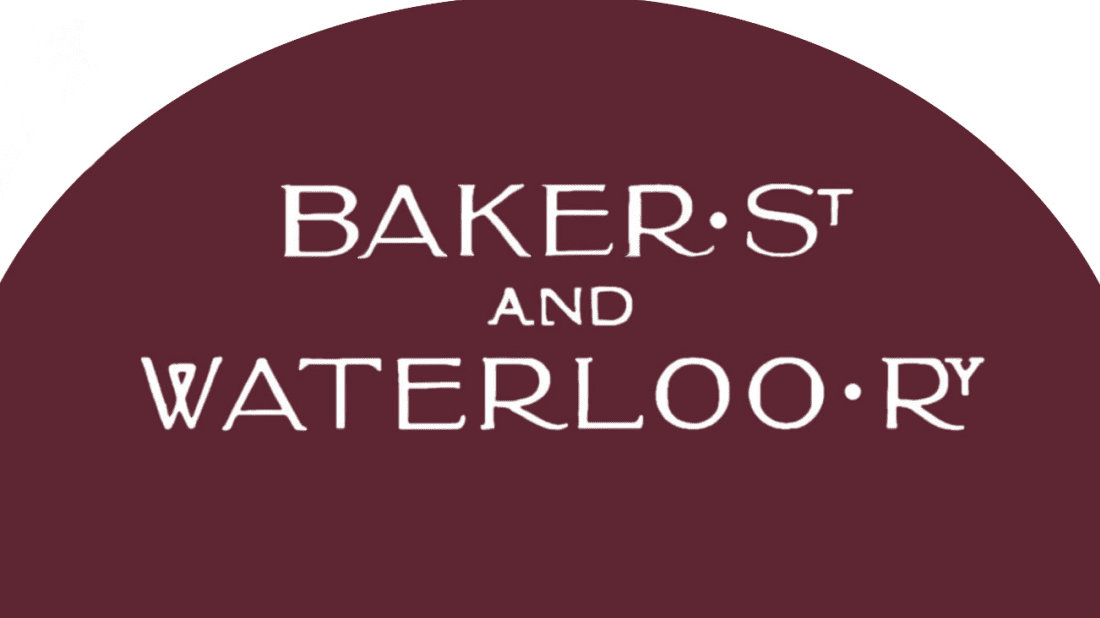
Even in somewhat abbreviated form the Baker Street and Waterloo Railway was still a bit of a mouthful! Image created by author based on old photographs of the station frontage at Waterloo.
In a nutshell ‘Bakerloo’ had been far more popular prior to the line’s opening than any credence the history books and blogs have given. As for ‘Quex’ well that sort of confused things a bit! First its a tad misleading because there seems to be a dearth of articles penned by the person in question! Those referring to ‘Quex’ don’t appear to have a single actual reference that can be linked to the mysterious person.

The mystery of Quex. The Bakerloo name became ‘accepted currency’ by May 1906 and in June the company announced the line would be known by that name. Extract from History of the Bakerloo Line (2021).
Its not known who alluded to ‘Quex’ (G. H. F. Nichols.) originally, however one early suggestion comes from John R. Day, the author of The Story of London’s Underground (1963). Day says, ‘The useful, at first disliked, but later adopted portmanteau name of ‘Bakerloo’ is believed to have originated with ‘Quex’ of the Evening News.’
In 1966 the Railway World magazine discussed ‘Quex’ briefly, however it seems the information was basically a development of what John Day had revealed some three years earlier. Then again, that information probably was derived from C. Hamilton Ellis in his British Railway History (1959), and further from the Railway Magazine in 1956. Prior to that it was the Institute of Transport’s Journal (1954) who had asserted it was Quex and then further back it was the Railway Gazette (1937) who had claimed the same and they had also mentioned it in the Railway Magazine for 29 June 1906. Unfortunately there doesn’t seem to be any source where a copy of that magazine – unlike those that can be found for the later magazines at both Google Books and the Internet Archive – thus the initial veracity cannot be examined.
One thing can be said however from research undertaken by London Rail is that ‘Quex’ did not pen for the Evening News until about 1915 (although he did write for the regional newspapers) thus ‘Bakerloo’ isn’t even his suggestion. This follows what others have said – that ‘Quex’ couldn’t have suggested it because he wasn’t even employed by the paper in question at the time. On the other hand as will be seen later ‘Punch’ does refer to the Evening News as the originator of the said name, so it may have been someone other than Quex. It may well be the newspaper edition in question isn’t available in any of the archives which can currently be perused thus the origination of ‘Bakerloo’ remains a mystery.
There shall be no other name – except the Bakerloo…
Bakerloo was no doubt the preferred choice. Even so there were those who disliked it and there were calls for the person (or persons maybe) responsible for “the Bakerloo tube”…’ to be hung high. Yes, strung up and hung for all to see. Hanging as a form of penalty still existed however the legal system would have not dared hang someone for so trivial a matter!
There’s no certainty the new ‘Bakerloo’ name caused disgust. The company’s staff turned their noses up at it. The Railway Magazine viewed the new name as a gutter title. On the contrary, there were those who steadfastly defended ‘Bakerloo’. The Daily Chronicle (26th June 1906) came to the defence of those who had coined the new name and suggested instead of hanging the miscreants, they ought to be canonised.
Canonisation was certainly a thing the Bakerloo itself took to later when the name became accepted by the company. Many signs and adverts extolling the new railway were signed with the two ‘O’s being linked in apparent religious unity. (The feature image at the top of this page is but one example of that).
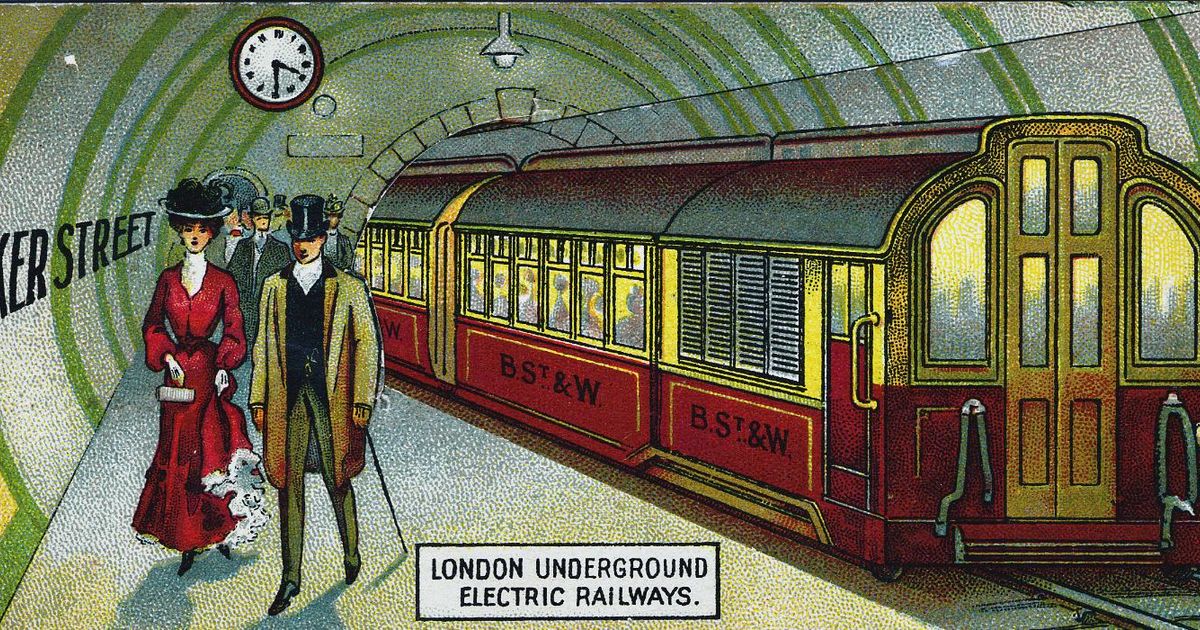
The Bakerloo – early publicity card used by the Underground Electric Railways for its different lines with the names changed for each. LT Museum.
Research by London Rail shows a considerable number of papers were already adept at using the new name well before the line’s opening. Here are a few examples…
Some entities (the Daily Express and the Hippodrome) insisted on Baker-loo whilst others (the Evening News) insisted on using Bakerloo. One of the title’s strongest advocates, the Daily Chronicle (15th March 1906), queried why those using Baker-loo were not able to use Bakerloo. As the paper pointed out, Waterloo, Peterloo, and others didn’t require a dash in between, thus Baker-loo didn’t make sense when ‘Bakerloo goes naturally.’
Despite the name being ‘accepted currency’ by May 1906, it appears it was already valid currency by the day the line opened with most being in the supporting camp. By then few had obviated any need to call the railway by its official name.
It seems the name was coined a mere few days before the line’s opening and it spread like wildfire. One example being the Globe (6th March 1906) carried a suggestion the new line should be called the Bakerloo Railway and then the dominos fell in quick succession with many newspapers scrambling to give their penn’orth on the new name.
The Daily Express led, apparently, with the quest for the new name. On 8th March 1906 it headed a report on the Baker Street and Waterloo with the title ‘The Baker-loo Railway.’ Since this was a daytime newspaper, that no doubt had come hot on the heels of the Evening News the previous night.
The Middlesex and Surrey Express, West Middlesex Herald, and Southall Guardian for 9th March 1906 cited: ‘What has been somewhat aptly christened the “Bakerloo,” London’s new tube railway, running from Baker Street to Kennington Road, will be opened for public traffic tomorrow.’
That very same day the Evening News carried a report on the new Baker-loo. It announced the day of opening (10th March) and informed the reader the new line had already carried its first passengers (these being newspaper journalists).

Baker Street & Waterloo Railway 1906 map. Green was later adopted as the line’s colour. Mapping London.
Those brightly coloured ‘rainbow’ tube stations…
This is an overview of what the station tiles were going to be as detailed in 1906 and what they are now – or as one will read later rather – including the three stations that were opened later in 1906 and during 1907.
The Daily Express led an editorial on the 9th March 1906 extolling the beauty of the line’s new stations and said the new tube line was rainbow coloured. It must be said barely any of the stations sport any semblance of a truly rainbow coloured tube these days! The following is an edited extract from that 1906 article:
The Rainbow Tube – 1,200,000 tiles variegate the Baker-loo Line:
All the stations of the Baker-loo Railway are as pretty as pictures with their bright hued tiles and the flying coloured bands…
The names of the stations are fired permanently on the tiles in bold letters, but this is only a precautionary measure, as the stations proclaim themselves in their colour schemes…
Kennington Road: Light green and dark green.
Waterloo: Green and dark brown.
Embankment: Green and light brown.
Trafalgar Square: All white (down platform), light green and light brown (up platform).
Piccadilly: Green and celeste blue.
Oxford Circus: Dark brown and blue.
Regent’s Park: Light brown and amber.
Baker Street: Oxford blue.
All the company’s booking halls are tiled in two greens, but the corridors and circular staircases are treated in the same colour as the platform to which they lead… (Daily Express 9th March 1906).
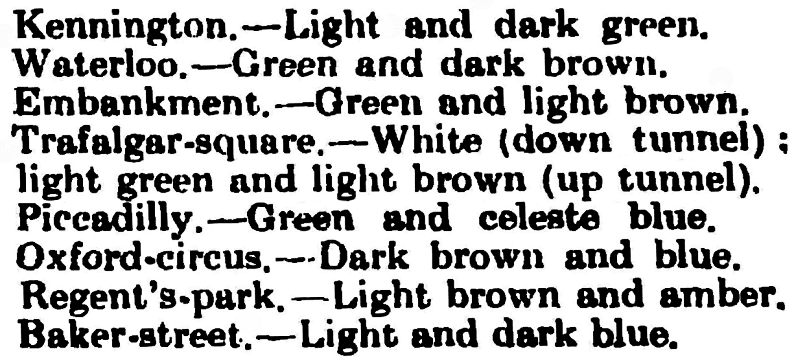
The same exact list was found in the Builder for 17th March 1906. Perhaps the and the Daily Express one were based on an official list of station colours the tube company had sent out? At least it can be seen Kennington Road (later Westminster Bridge Road and ultimately Lambeth North) does not have the colours that were originally specified. Note the slight switch for Baker Street which does at least denote the colours it had – which would have been Oxford blue and celeste blue.
Many ditties (songs or poems) or were written on the colourful stations London’s new Bakerloo railway sported. Evidently there was a quest to find who could write the best one of all! Here’s a short ditty related to the line’s new colourful stations:
Edwin and Angelina went shopping,
And to reach their destinations,
Decided on the best place for stopping
In one of the coloured stations.
But when the girl looked out on a ‘glare’,
She cried, in the greatest distress,
‘Could not possibly get out there,
For the colour won’t match my dress!’
Taken from the Truth newspaper, 11th April 1906.
More please! Okay here’s another – this time its an extract from The Tatler 21st March 1906:
A Bakerloo Ballad.
John Smith he laboured all the day, As many others do,
And wended then his homeward way By land and Waterloo.
He had a joke he did not make, But often would repeat-
“This tube,” said he, “just takes the cake, It is a Baker’s treat.”
His station and the ones between He carried in his head,
For some were brown and some were green, And thus they all were read.
But once when freely he did dine, The sight his eyes might vex,
When what was once a zig-zag line Became a double X!
The purple spots were bands of brown, The red to orange grew,
And long he travelled up and down, In fact, till all was blue.
Please sir, I… want… more! Whaaat! Okay just one more – and that’s yer lot! Otherwise I’ll be spending all day writing about the rainbow coloured Bakerloo tube!

One more from the Bakerloo tube! Extract from ‘The Rainbow Route’. The Bystander 28th March 1906.
And… its back to the future – that’s when the new Bakerloo tube finally opens!
The Bakerloo railway opens 10th March 1906…

On the day of the line’s opening and in spite of it already being referred to as the Bakerloo, the Baker Street and Waterloo Railway decided to be a spoilsport by sticking to its official title for the line’s opening announcements. Railway News 10th March 1906.
From Water Street to Bakerloo…
The Evening News (10th March) hailed the line’s opening with a specially penned ditty – “From Water Street to Bakerloo“:
Oh, booking clerk behind thy pane,
They pierced pane of gleaming glass,
I fain would travel by the train,
And through untainted tunnels pass,
Oh, proud official book me through
To Water Street or Bakerloo.
Yes, I would glide through many miles
Of white washed walls and lambent lights,
Artistically tinted tiles,
And all the other dear delights,
That which the eager eye may view,
Twixt Water Street and Bakerloo.
The skies are dull, the wind is cold,
High up the screaming seagulls soar,
But in those long lit lanes of gold,
I can be gay for evermore,
Aye, travelling in the fancy flue
From Water Street to Bakerloo.
Even Mr Punch dug asides at notions of the line being known as the Water Street tube! (See below).

Punch (28th March 1906) enthuses the forthcoming jeux d’esprit over the new tube’s name. Internet Archive.
Adverts in the newspapers were straight off the mark in extolling the line’s new name. The Hippodrome made sure of that in every advert it published. On the 10th of March (as in deed was the case before and after) its advert said ‘Hippodrome, Twice Daily. Alight at Piccadilly Circus (Baker-loo Railway)’.
Some might wonder why adjacent Leicester Square station wasn’t mentioned. It hadn’t yet opened and it would not do so for another good few months when the Piccadilly Railway opened.
Not a popular railway to start with…
No it wasn’t the name! It was that the line didn’t seem to give any new advantages over existing transport in London and its north to south diagonal axis wasn’t one which many were endeavouring to use either. It was agreed the buses proved more competitive. This surprised the company because it had been thought the line served a number of very important destinations: Baker Street, Oxford Street, Piccadilly, Charing Cross and Waterloo.
The line certainly was busy in the evenings and late at night when hordes of Londonders headed to and from the theatres, and the nominal rush hours also saw some additional patronage. As news reports extolled, the trains were completely empty for much of the time. As the modern observer would say, the trains were transporting no less than fresh air! Had it been worth the effort building the new tube? Couldn’t get its name right nor could it even attract patronage eh? Oh come on, give it a chance guys!
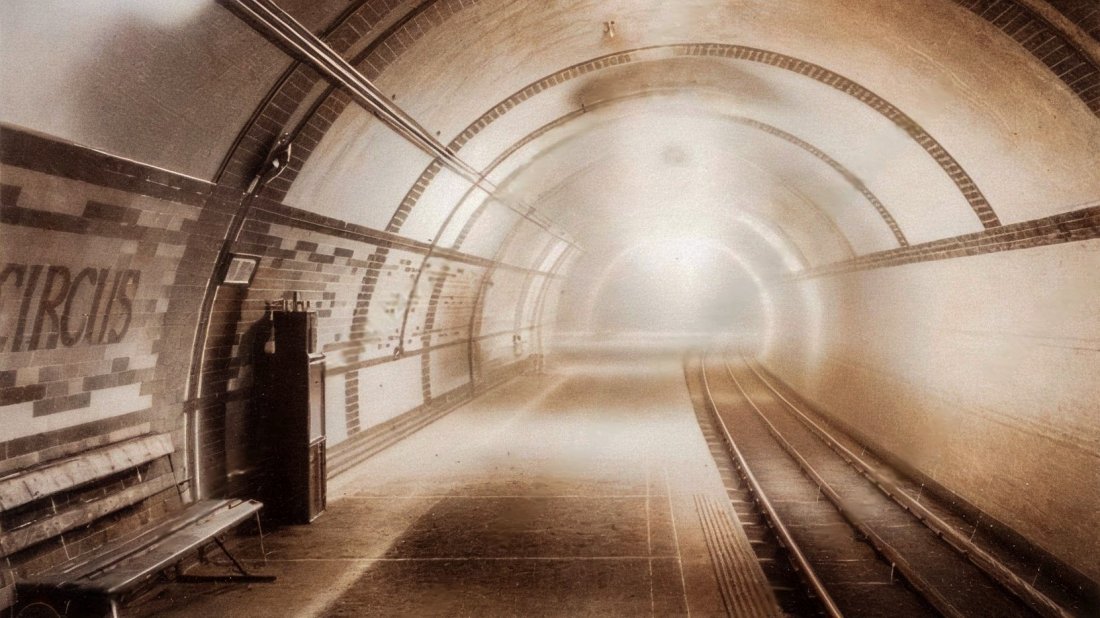
Not a soul to be seen at Oxford Circus! Actually this was a publicity photograph. Picture cleaned and upscaled by author from the Illustrated London News (17th March 1906).
London’s latest tube, or “Bakerloo”… does not seem to have caught on with the rapidity of its predecessor. There are complaints of empty carriages and general lack of popular patronage. There are probably several reasons for this, one of which is the competition of the motor omnibus. (Derby Daily Telegraph 14th April 1906).
The line’s opening had been well patronised with quite a few thousand using it in its first days. Then there was an ‘exceptional decrease of passengers’. The company said ten million passengers a year were to use the new line but it could not explain why actual numbers were so low. The buses were no doubt getting more competitive and new routes were being introduced quickly to suit passengers’ needs – and that was something the Bakerloo couldn’t do.
It struggled to find patronage. Most of the time five, ten, maybe fifteen passengers could be seen on each train. Certainly in the early mornings and in the evenings it was quite busy. The daytimes was no doubt when patronage was sorely needed. A number of references were made to the lack of passengers using the new line and this was still news a whole month after the Bakerloo had opened.
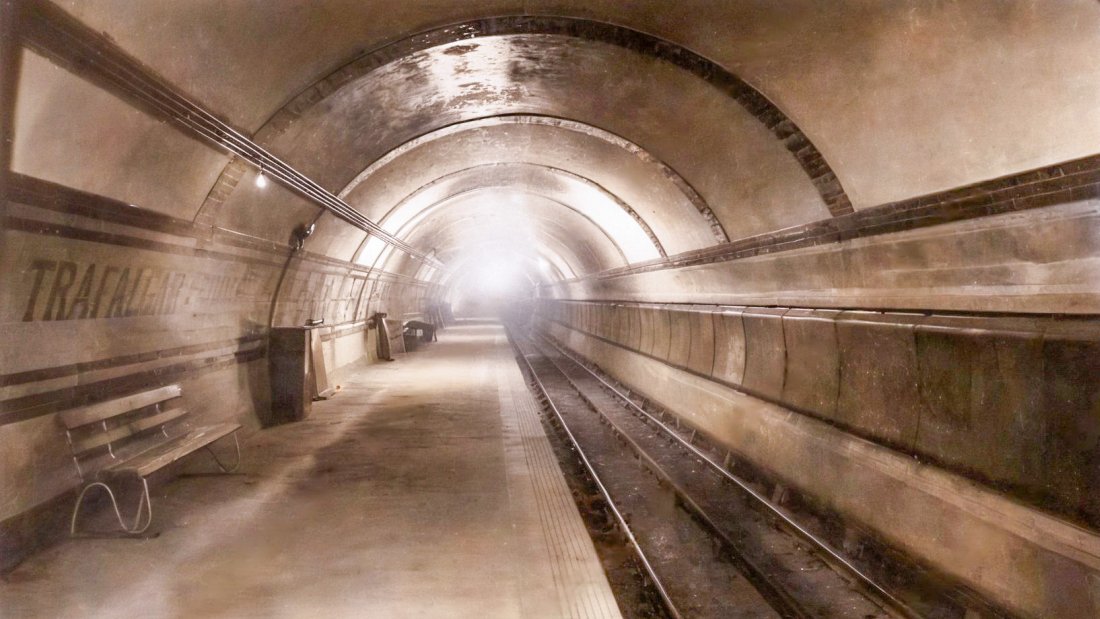
Not a soul to be seen at Trafalgar Square! Actually this was a publicity photograph. Picture cleaned and upscaled by author from the Street Railway Journal (27th March 1906)
During the weeks which have elapsed…. results have proved that it has comparatively few friends… It is difficult to understand why his should be the case because the railway itself is excellent. The carriages are clean, comfortable, and well lighted… combined with a frequent and rapid service, it must be admitted that the new line has so far been a failure. (Southwark and Bermondsey Recorder 7th July 1906).
Four months later it was still the case the new line was struggling. There is every possibility the company’s announcement it would use the new name (Bakerloo) was in every way designed to endear more patronage. In a sense that was achieved however the line’s fares were something many had called in to question, with many being of the opinion that its fortunes would not alter until its fares were reduced.
From 22 July 1906 the company reduced some of its fares to just ‘one penny’ (as the news put it – rather it was a penny and a half in fact) in an attempt to attract passengers. Those cheap penny fares applied to trips from Piccadilly Circus to either Baker Street or Waterloo. Following this the results were beginning to be seen, but it was a slow road ahead.
Even stations such as Trafalgar Square struggled well into the 1920s – and this forced the Underground Electric Railways Company to begin reducing the number of staff employed. More on that in a bit…

Leave a Reply